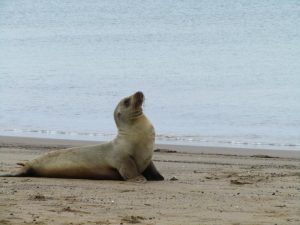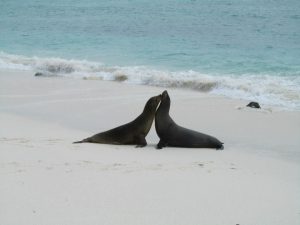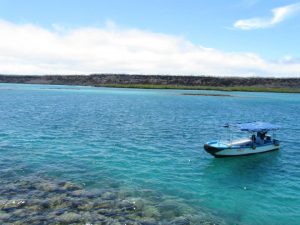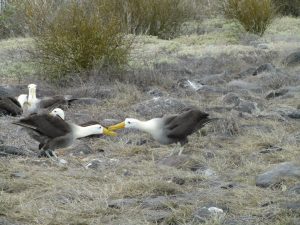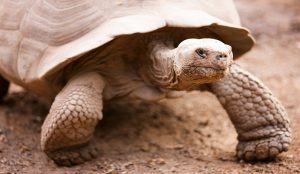 Print Itinerary
Print Itinerary
Inclusions:
- 5 Overnights in middle class hotels in Galapagos
- Transfers and guided tours in Galapagos
- Daily Breakfast
- The unique opportunity of explore the unique Archipelago of Galapagos!
Guaranteed Departure Dates
- 07 JAN 17
- 11 FEB 17
- 04 MAR 17
- 25 MAR 17
- 06 MAY 17
- 17 JUN 17
- 08 JUL 17
- 12 AUG 17
- 09 SEP 17
- 14 OCT 17
Day 1 BALTRA AIRPORT - SANTA CRUZ ISLAND (L)
You arrive at Baltra Island. From the airport you take a bus to the Itabaca Canal where you head by ferry to the other side of the Island of Santa Cruz.
With a surface of 986 km2, Santa Cruz is the second largest island of the Archipelago. Colonized since the 1920’s, Puerto Ayora, the populated part of the island, is the most important harbour in the Archipelago. With altitudes reaching 864 m this island comprises all plant zones, ranging from coast to pampas. The headquarters of the Galapagos National Park and the Charles Darwin Station are also located in Santa Cruz.
During the transfer through the highlands of Santa Cruz you can observe the enormous change of vegetation that ranges from dry areas full of cacti to rainforest and fern zones. The green landscape of this area is a welcome contrast to the more arid scenery of the smaller, lower islands. During a short stop you have the opportunity to take pictures of the Twin Craters. Located one in front of the other on both sides of the road connecting Puerto Ayora to Baltra, the Twin Craters are a magnificent site. They were formed as a result of the collapse of the crust into the crater. There are many craters of this type in the area, which signals the possibility that these craters are all elements of the same fissure. The vegetation of this area is dominated by Scalesia Trees, which make the site a beautiful green landscape. You will visit a lava tunnel, a fun and geologically informative visit. Taking a short walk you can also observe the famous giant tortoise in its natural environment.
Enjoy lunch in a typical Hacienda.
After your check-in sy the Hotel you’ll continue directly to the Charles Darwin Station. Visiting the Charles Darwin Research Station, you will have the opportunity to see how the conservation of the islands is conducted, and understand the huge efforts that scientists, park rangers and park managers among others have to make to preserve this UNESCO World Heritage Site. Above all, the reduction of imported animals is very important for the natural balance of the archipelago. The Research station supports scientists all over the world with their work in the Galapagos.
Overnight at a Hotel on Santa Cruz Island
Day 2 SEYMOUR NORTH or SOUTH PLAZAS or BARTHOLOMEW ISLAND or SANTA FE ISLAND or DRAGON HILL (B - L)
During a full day boat excursion you’ll visit one of the islands either Seymour North, South Plazas, Bartholomew, Santa Fe or Dragon Hill. Each of the islands has its own significant beauties to offer and regardless which one you visit, you’ll definitely enjoy your stay. Lunch on board.
Overnight at a Hotel on Santa Cruz Island.
Day 3 SANTA CRUZ - FLOREANA ISLAND (B - L - D)
After breakfast you will be transferred on a speed boat to Floreana Island (approx. 2,5 hours). Lunch at the hotel.
In the afternoon, you will visit “Loberia”, a small peninsula with colonies of sea lions. The rest of the afternoon you are free to relax at the “Bahia Negra”, the beach next to the hotel. Dinner and overnight at hotel on Floreana Island.
Day 4 FLOREANA ISLAND - ISABELA ISLAND (B - L)
In the morning, you will visit the highlands of Floreana Island. An approximately 1.5-2 hour hike leads you through the stunning vegetation of the Island. You will also see the only freshwater source of the island before going on to the pirate caves. The family Wittmer, upon their arrival, sought refuge here as well.
Afterwards, you will be transferred by speed boat to Isabela Island (approx. 2 hours) Isabela Island is the largest island in the archipelago with a total area of 4.588 km2. Composed by six shield volcanoes that have merged into a single land mass, it also has the highest point of the islands: The Wolf Volcano is 1.700 m high and the equatorial line runs straight through its massive crater. Lunch will be served at the hotel.
In the afternoon, you will visit “Las Tintoreras” which is located only a short distance from Puerto Villamil. After a short boat journey, you will go ashore to see a colony of white tipped reef sharks resting in a lava canal, sometimes accompanied by other sharks and sea lions. Nearby hundreds of marine iguanas can be observed, as “Las Tintoreras” is one of their main breeding sites. On the sandy beaches sea lions play and relax in the sun. This is one of Isabella’s most beautiful visitor sites. On the way back to Puerto Villamil, you may get the chance to see penguins and blue-footed boobies on the rocks. Overnight at a Hotel on Isabela Island.
Day 5 ISABELA ISLAND (B - L - D)
Sierra Negra is located in the South of Isabela Island in between the volcanoes Alcedo and Cerro Azul. It’s crater with a diameter of about 10 kilometres is the biggest on Galapagos and the second biggest in the world, right after Ngoro Ngoro in Africa.
The excursion to the crater starts in Puerto Villamil. From here an one hour transfer by bus brings you to the starting point of the hiking trail, which leads you in a 1.5 hour walk to the rim of the crater, from where you can enjoy a spectacular view over the crater and on clear days to the island Fernandina located west of Isabela.
Note:In case there is bad weather conditions in the highlands of Isabela and hiking is not possible, an alternative excursion will be arranged.
Lunch will be served in a Hacienda in the highlands. Afterwards you visit the Galapagos National Park’s Giant Tortoise Breeding Centre, where you can see many subspecies of tortoise at different stages of development and admire these giant and fascinating animals. Since 1965 the station is the breeding and rearing place for the famous Galapagos or Giant Tortoises that give the name to the archipelago. These fascinating primeval animals are threatened by extinction. Here they live safely until the age of five before they are set free onto their origin islands. The centre also provides a good opportunity to photograph tortoises of all sizes.
Later you head for the Laguna of the Flamingos, Pozo de los Flamingos, where you have the rare opportunity to observe these animals very closely. In the late afternoon you can relax and enjoy the beautiful beach of Puerto Villamil. Dinner and overnight at a hotel in Isabela Island.
Day 6 ISABELA ISLAND - BALTRA (B)
After breakfast, the speed boat takes you to Puerto Ayora on Santa Cruz Island from where you will be transferred by bus to Itabaca Channel. From here you will be accompanied by ferry and bus to the Baltra airport to take the flight to Guayaquil or Quito.
Extension programs, as a beach stay or a stopover in Quito can be arranged by Latino Holidays.
End of our services
Food Code = (B) – Breakfast, (L) – Lunch, (D) – Dinner.
LHSTGPS001 *Please note, prices based on twin share, per person, low season, 3 star rates. 4 passengers is the minimum requirement for the tour to be guaranteed. The itinerary & pricing can change at any time due to availability & of activities. Please check our website for full terms and conditions*
More on Ecuador:
Ecuador – The State of the Andes has its name because of its location on the equator. Ecuador is situated in the northwest of South America and borders in the north with Colombia, in the east and south with Peru and borders in the west upon the Pacific Ocean. The Galapagos Islands, situated in the Pacific Ocean, with a distance to the continent of about 1000 km, belongs to the national territory of Ecuador.
More about Galapagos:
Galapagos – the Enchanted Islands – doubtlessly are the highlight of every Ecuador trip and you also should not miss a visit, for it is the most unique living museum of evolutionary changes and you would get to know a variety of exotic species endemic to this Archipelago! Galapagos is the perfect setting to experience the evolutionary changes, which have led to a new understanding of life on earth. Animals unafraid of man and so different from any others found elsewhere, make visitors wonder about their existence on our planet. Among the animals found, are the different species of giant “Galapagos” tortoises that gave the islands their name, a variety of birds and marine mammals such as iguanas, sea lions, dolphins, whales as well as a great number of fish. Among the flora, the most distinctive are mangroves and endemic cacti -to mention only a few!
Visa Requirements to Ecuador:
Visas are not required for Australians when the maximum stay is 90 days.
When visiting Galapagos you must obtain a Transit Control Card – Fee: USD 20.00 (Ingala Fee)* and the Galapagos Entrance fee*: USD 100.
*Note: these fees are subject to change at any time without prior notice.
For more information consult your nearest Ecuadorian embassy/consulate.


